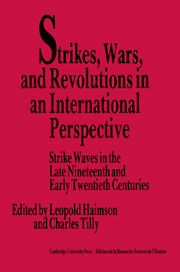 Strikes, Wars, and Revolutions in an International Perspective
Strikes, Wars, and Revolutions in an International Perspective Book contents
- Frontmatter
- Contents
- List of contributors
- Preface
- Part I Introductions
- Part II Models and realities
- Part III Workers in metal-processing enterprises in comparative perspective
- 11 From the mechanic to the metallo
- 12 Strikes of machinists in the United States, 1870–1922
- 13 The political economy of British engineering workers during the First World War
- 14 The rationalization of class struggle: strikes and strike strategy of the German Metalworkers' Union, 1891–1922
- 15 Scientific management and the changing nature of work in the St. Petersburg metalworking industry, 1900–1914
- 16 Structural processes of change and changing patterns of labor unrest: the case of the metal-processing industry in Imperial Russia, 1890–1914
- 17 Social characteristics, attitudes, and patterns of strike behavior of metalworkers in Italy during the First World War
- Part IV The effects of short-term variation
- Part V Conclusion
17 - Social characteristics, attitudes, and patterns of strike behavior of metalworkers in Italy during the First World War
Published online by Cambridge University Press: 25 March 2010
- Frontmatter
- Contents
- List of contributors
- Preface
- Part I Introductions
- Part II Models and realities
- Part III Workers in metal-processing enterprises in comparative perspective
- 11 From the mechanic to the metallo
- 12 Strikes of machinists in the United States, 1870–1922
- 13 The political economy of British engineering workers during the First World War
- 14 The rationalization of class struggle: strikes and strike strategy of the German Metalworkers' Union, 1891–1922
- 15 Scientific management and the changing nature of work in the St. Petersburg metalworking industry, 1900–1914
- 16 Structural processes of change and changing patterns of labor unrest: the case of the metal-processing industry in Imperial Russia, 1890–1914
- 17 Social characteristics, attitudes, and patterns of strike behavior of metalworkers in Italy during the First World War
- Part IV The effects of short-term variation
- Part V Conclusion
Summary
The new class of Metalworkers and the First World War
The First World War induced great changes in the character of the working class and in industrial relations. The slow evolution of industrial relations since the turn of the century, and the very foundations of the social structure were abruptly upset – so much so that it was said that “the war was veritably a typhoon that radically changed the structure of Italian society and modified, at the same time, its social texture.” A new working class emerged, forged in the miliarized factories, changed in its organic composition, younger and more impatient than the one that had fought the big trade unions battles during the Giolitti period.
The Great War altered the patterns of industrial relations that had slowly become established in the Giolittian era. During the war, hiring contracts and collective wage agreements assumed a political and legal significance unknown in earlier legislation. Trade unions and employers discovered different, often compulsory mechanisms for mediating labor conflicts. The more progressive members of the political and administrative classes, and later employers and trade unions, sought to put some order in the customs and regulations that had built up through the years, and to set up an organic and binding system of industrial relations. The great structural changes that took place in industry thus made possible the emergence of a uniform set of rules governing social relations in industrial firms.
- Type
- Chapter
- Information
- Strikes, Wars, and Revolutions in an International PerspectiveStrike Waves in the Late Nineteenth and Early Twentieth Centuries, pp. 402 - 430Publisher: Cambridge University PressPrint publication year: 1989


